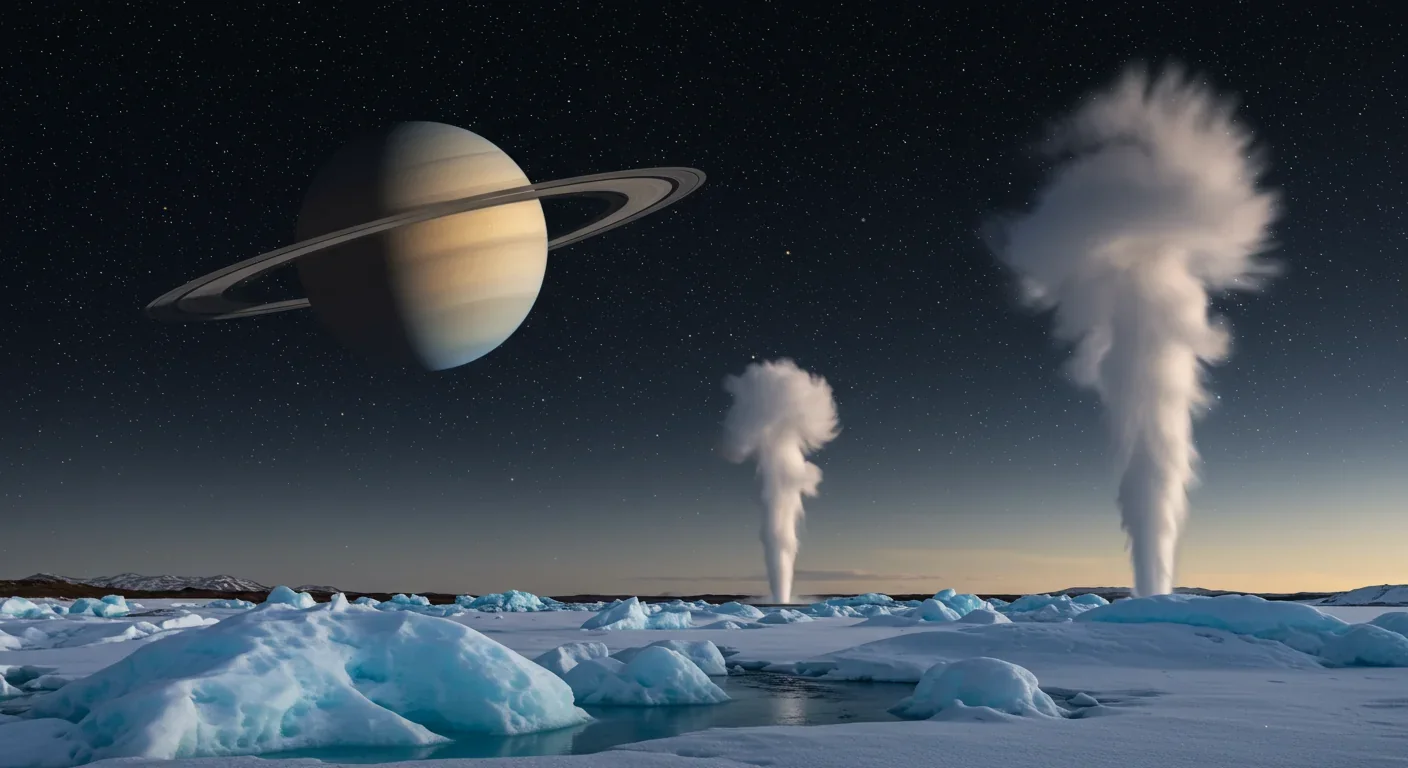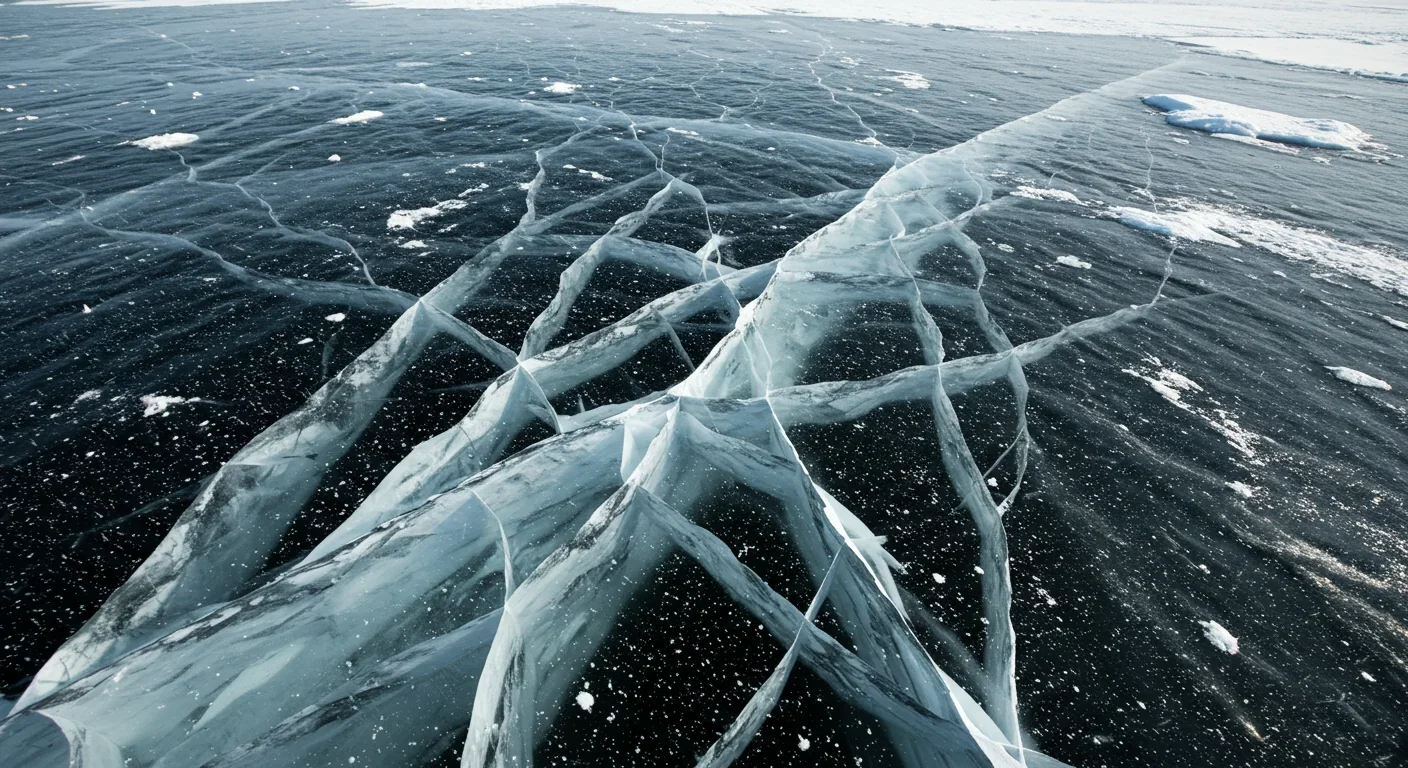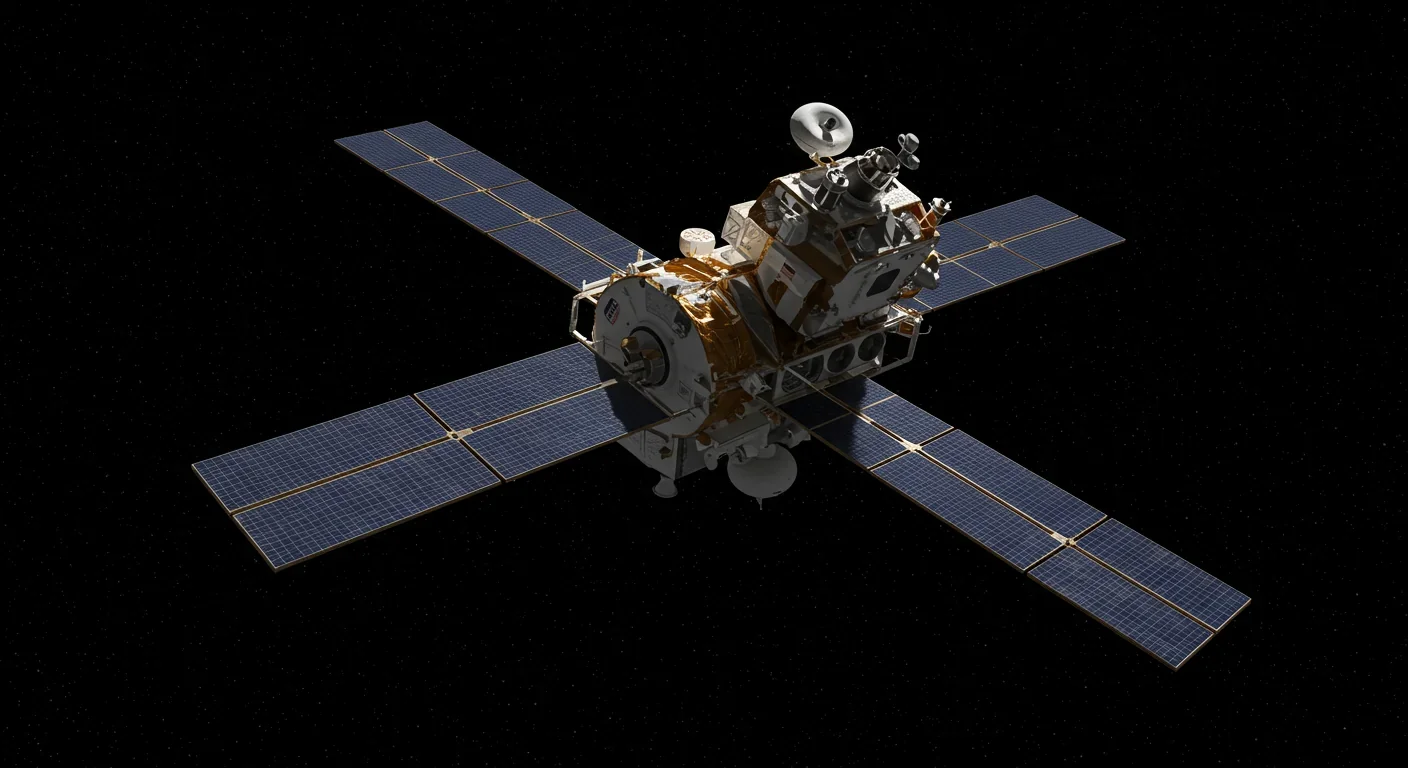Mars Methane Mystery: Hidden Microbes or Geology?

TL;DR: Europa and Enceladus host ice volcanoes that erupt water and organic molecules from subsurface oceans into space, creating natural sampling opportunities for detecting extraterrestrial life. NASA missions are revolutionizing our search.
Somewhere beneath the frozen crust of distant moons, oceans twice as deep as Earth's may be erupting into space right now. These aren't your typical volcanic explosions—they're cryovolcanoes, icy fountains blasting water, organic molecules, and the chemical ingredients for life hundreds of kilometers above alien surfaces. What makes them extraordinary isn't just their existence, but what they reveal: subsurface oceans that might be teeming with microbial ecosystems we've only begun to imagine.
Jupiter's moon Europa and Saturn's moon Enceladus have become the solar system's most tantalizing laboratories for astrobiology. Unlike Mars, where we search for ancient traces of water, these ocean worlds are spewing their secrets into space through spectacular plumes. NASA's Cassini spacecraft flew directly through Enceladus's geysers, sampling water that erupted from an ocean floor possibly crawling with life. Now, Europa Clipper, launched in October 2024, is racing toward Jupiter to investigate whether Europa's ice volcanoes hide similar biological potential.

The implications stretch beyond academic curiosity. If life exists in these alien oceans—hidden beneath ice shells kilometers thick, warmed by tidal forces rather than sunlight—it would fundamentally rewrite our understanding of where life can emerge and thrive.
Traditional volcanoes erupt molten rock heated by radioactive decay deep in planetary interiors. Cryovolcanoes operate on an entirely different principle. Instead of lava, they erupt "cryolava"—a mixture of liquid water, ammonia, methane, and other volatiles that remain liquid at temperatures hundreds of degrees below zero.
The physics of cryovolcanism presents a fascinating challenge. Water is denser than ice, which means liquid water should sink rather than rise through an ice shell. Yet these moons overcome this barrier through chemistry: dissolved ammonia and other compounds reduce the density of subsurface liquids just enough to create buoyant plumes that can breach the surface.
Dr. Rosaly Lopes explains: "For life as we know it to exist, we need water and energy—cryovolcanism provides the heat (energy) and it is a way to bring material that may have biosignatures to the surface of bodies."
This natural sampling mechanism eliminates the need for drilling through kilometers of ice, a technological feat that remains decades away.
On Enceladus, over 100 geysers concentrated near the south pole shoot material at velocities exceeding 1,200 kilometers per hour. These jets collectively eject approximately 250 kilograms of material every second—enough to supply Saturn's entire E ring with fresh ice particles. The plumes reach altitudes of 500 kilometers, far higher than the International Space Station orbits above Earth.
Europa's cryovolcanic activity appears more intermittent and harder to observe. Hubble Space Telescope observations have detected what may be water vapor plumes reaching 200 kilometers above Europa's surface, though confirmation remains elusive. Unlike Enceladus's continuous display, Europa may experience episodic eruptions triggered by tidal stresses that crack the ice shell at specific points in its orbit.

The energy driving cryovolcanism doesn't come from radioactive decay like Earth's volcanism. Instead, these moons are powered by one of the universe's most elegant mechanisms: tidal heating generated by orbital resonances.
Enceladus orbits Saturn in a gravitational dance with sister moons Dione and Tethys. This orbital resonance—where Enceladus completes exactly two orbits for every one orbit of Dione—forces Enceladus into a slightly elliptical path. As it moves closer to and farther from Saturn, the massive planet's gravity literally flexes the moon, stretching and compressing it like a rubber ball.
This constant kneading generates tremendous internal heat. Cassini's thermal measurements revealed that energy output from Enceladus's south pole exceeds predictions by a factor of ten. The tiger stripe fractures—four parallel cracks each over 100 kilometers long—glow at temperatures around -120°F, nearly 200 degrees warmer than the surrounding terrain at -330°F.
"The energy output from Enceladus south pole exceeds predictions by a factor of 10, indicating intense internal heating."
— Cassini Mission Data
Europa experiences even more extreme tidal forces from Jupiter's massive gravity, compounded by orbital resonances with the moons Io and Ganymede. Models suggest tidal heating generates enough warmth to maintain a global ocean 60 to 150 kilometers deep beneath an ice shell 15 to 25 kilometers thick. The constant flexing creates stress fractures in the ice—potential pathways for subsurface water to reach the surface.
The tidal mechanism has profound implications for habitability. Unlike Earth's oceans, which rely on sunlight for most biological productivity, these subsurface seas could sustain ecosystems powered entirely by geothermal energy. This expands the "habitable zone" concept beyond planets at just the right distance from their star to include icy moons orbiting giant planets anywhere in a solar system.
When Cassini plunged through Enceladus's plumes in 2008, its Ion and Neutral Mass Spectrometer captured data that electrified the astrobiology community. The spacecraft detected water vapor, carbon dioxide, methane, ammonia, and molecular hydrogen—precisely the chemical cocktail needed to support microbial life.
The molecular hydrogen discovery proved particularly significant. On Earth, hydrogen forms when hot water reacts with certain minerals in a process called serpentinization. The reaction occurs at hydrothermal vents on the ocean floor, where superheated water meets iron-rich rocks. These same vents host thriving ecosystems of bacteria and archaea that derive energy from chemical gradients rather than sunlight.

Cassini also detected silica nanoparticles in the plumes—microscopic grains of silicon dioxide that only form when liquid water interacts with rock at temperatures above 90°C. This discovery confirmed that Enceladus hosts active hydrothermal systems on its ocean floor, where mineral-rich water circulates through fractures in the rocky core.
Silica nanoparticles in Enceladus's plumes prove water interacts with rock at temperatures above 90°C—the signature of active hydrothermal vents that could support life.
The organic molecules detected include methane, propane, ethylene, and even complex carbon compounds. While these organics could form through non-biological processes, their presence alongside molecular hydrogen creates conditions favorable for methanogenesis—the metabolic pathway used by some of Earth's most ancient microbes.
Europa's chemical composition remains less certain because we haven't sampled its potential plumes directly. However, spectroscopic observations reveal surface compounds including water ice, sulfuric acid, hydrogen peroxide, and salts like sodium chloride and magnesium sulfate. These chemicals likely originate from the subsurface ocean and reach the surface through fractures and possible cryovolcanic activity.
The presence of salts indicates Europa's ocean maintains chemical contact with its rocky seafloor—a crucial requirement for the water-rock reactions that could provide energy for life. Surface features called chaos terrain show evidence of partial melting and refreezing, suggesting localized upwelling of warmer subsurface material.
Europa Clipper carries instruments specifically designed to analyze plume composition if the spacecraft encounters active eruptions during its 49 planned flybys starting in 2030. A mass spectrometer will measure the molecular makeup of any ejected material, while a surface dust analyzer will study microscopic particles. These measurements could reveal whether Europa's ocean contains the same life-friendly chemistry observed at Enceladus.
The surfaces of Europa and Enceladus tell dramatically different stories about their internal dynamics, yet both reveal the fingerprints of cryovolcanic processes that connect icy crusts to hidden oceans.
Enceladus's south polar region displays four prominent fractures nicknamed tiger stripes—Alexandria, Cairo, Baghdad, and Damascus sulci. These parallel features stretch over 100 kilometers and gape up to 500 meters wide. High-resolution Cassini images revealed that the stripes consist of multiple smaller fractures with raised ridges along their edges, resembling terrestrial rift zones where tectonic plates separate.
The tiger stripes remain warmer than surrounding ice, indicating ongoing heat flow from below. Thermal imaging shows temperatures reaching -120°F along the fractures compared to -330°F just kilometers away—a temperature gradient that powers the continuous plume activity. The ice above the fractures measures only about 5 kilometers thick, thin enough for pressurized subsurface water to breach the surface.

Europa's 3,100-kilometer diameter surface tells a more complex geological story. Vast regions of relatively smooth ice are crisscrossed by thousands of dark linear features—cracks and ridges that extend for hundreds or thousands of kilometers. Some ridges rise 300 meters above the surrounding terrain, possibly formed by repeated cycles of fracturing and refreezing as tidal forces flex the ice shell.
The most intriguing features are patches of chaos terrain—jumbled blocks of ice that appear to have broken apart, rotated, and refrozen in new positions. These regions may form when warm subsurface water partially melts the ice from below, causing the surface to collapse and fragment. Some chaos terrain shows evidence of darker material that may represent ocean material or rocky debris brought up from depth.
Small dome-shaped features called lenticulae (Latin for "freckles") pepper Europa's surface. Many scientists interpret these as sites where blobs of warm ice or liquid water rose through the shell, creating localized melting before freezing again—a form of cryovolcanic resurfacing. If this interpretation proves correct, lenticulae represent fossil cryovolcanoes that might still become active when tidal stresses crack the overlying ice.
Europa's relatively young surface age—estimated at 40 to 90 million years—suggests ongoing resurfacing erases older craters. This geological youth indicates either continuous ice tectonics or periodic cryovolcanic activity that deposits fresh ice across large areas.
The thickness of Europa's ice shell remains uncertain, with estimates ranging from 15 to 25 kilometers. Thinner regions would more easily allow cryovolcanic eruptions to break through, while thicker ice might trap subsurface water unless tidal cracking creates pathways to the surface. Europa Clipper's ice-penetrating radar will map shell thickness across the moon, identifying regions where plumes are most likely to erupt.
Before 2005, planetary scientists suspected Enceladus might be geologically dead—just another cold, cratered iceball. Then Cassini detected something extraordinary: a warm south polar region surrounded by surprisingly few impact craters, suggesting recent geological activity.
During a close flyby, Cassini's magnetometer recorded disturbances in Saturn's magnetic field near Enceladus—the signature of electrically conductive material being ejected into space. Subsequent targeted flybys brought Cassini within 50 kilometers of the surface, flying directly through the plumes while instruments captured unprecedented data.
The spacecraft's Cosmic Dust Analyzer measured particle sizes and trajectories, revealing ice grains ranging from sub-micron to several microns. Impact velocities indicated eruption speeds consistent with water vapor jets escaping through fractures under significant subsurface pressure.
"The plumes are a window into a hidden ocean that is in contact with the rocky core."
— NASA Cassini Mission Brief
Cassini's cameras captured spectacular backlit images showing dozens of individual jets erupting simultaneously from the tiger stripe fractures. These images allowed scientists to trace jets back to specific source locations, revealing that the plumes emerge from multiple vents spaced along each fracture rather than from single point sources.
Over multiple flybys between 2005 and 2017, Cassini documented variability in plume intensity correlating with Enceladus's orbital position. Plumes strengthened when the moon's elliptical orbit carried it farthest from Saturn, suggesting tidal stress opens fractures wider during certain phases, allowing more material to escape.

The mission's gravity measurements revealed crucial evidence for a global subsurface ocean. By precisely tracking Cassini's velocity as it passed Enceladus, scientists detected a gravitational signature indicating dense material beneath the ice—consistent with a liquid water ocean 26 to 31 kilometers deep, lying beneath an ice shell 30 to 40 kilometers thick at the equator but only 5 kilometers thick at the south pole.
These measurements transformed Enceladus from a curiosity into one of the solar system's highest-priority targets for life detection. As Dr. Rosaly Lopes noted: "If the material just stays in the ocean under an ice crust, it could be many decades before we are able to sample it." Enceladus solves this problem by delivering ocean samples directly to space.
Launched on October 14, 2024, Europa Clipper is now traveling 1.8 billion miles toward Jupiter, scheduled to arrive in April 2030. This $4.25 billion mission carries the most sophisticated suite of instruments ever sent to study an ocean world beyond Earth.
The spacecraft is genuinely enormous—the largest NASA has ever built for planetary exploration. With its solar arrays fully deployed, Europa Clipper spans over 30.5 meters, about the length of a basketball court. These massive panels are necessary because sunlight at Jupiter's distance is 25 times weaker than at Earth, yet the spacecraft needs substantial power to operate nine scientific instruments simultaneously.
Europa Clipper won't orbit Europa directly—Jupiter's intense radiation would fry electronics within weeks. Instead, the spacecraft will orbit Jupiter itself, making 49 close flybys of Europa at altitudes as low as 25 kilometers. Each flyby will scan a different region, ultimately mapping nearly the entire moon.
To survive Jupiter's radiation environment, all sensitive electronics are enclosed in a thick-walled titanium and aluminum vault—technology proven by the Juno spacecraft. Even with this protection, Europa Clipper's mission is designed to last only a few years before accumulated radiation damage becomes critical.
Europa Clipper will make 49 close flybys at altitudes as low as 25 kilometers—close enough to fly through any active plumes and sample ocean material directly.
The mission's primary goal is to determine whether Europa currently has habitable conditions. Several instruments target aspects of cryovolcanism and ocean detection directly.
The Radar for Europa Assessment and Sounding: Ocean to Near-surface (REASON) will beam radio waves through the ice shell, measuring its thickness and internal structure. The instrument may detect subsurface water pockets or even the ocean itself if the ice is thin enough. A successful test flyby of Mars in December 2024 confirmed REASON's capabilities, with the instrument collecting 6 gigabytes of rich subsurface data during a 40-minute pass.
The Europa Thermal Emission Imaging System (E-THEMIS) will create infrared maps of the surface, identifying warm spots that might indicate recent cryovolcanic activity. By pinpointing locations where ice is warmer than its surroundings, scientists can target areas where eruptions may have occurred recently or could occur during the mission.
The MAss Spectrometer for Planetary EXploration (MASPEX) will analyze gases in Europa's tenuous atmosphere, including any ejected from active plumes. If Europa Clipper flies through a plume—as Cassini did at Enceladus—MASPEX will measure the molecular composition in unprecedented detail, potentially detecting organic molecules, salts, and other compounds from the ocean.
The SUrface Dust Analyzer (SUDA) will catch and analyze microscopic ice grains and dust particles ejected from Europa's surface or plumes. By measuring the composition of these tiny samples, scientists can determine what chemicals are present in Europa's subsurface environment.
Magnetometers will measure Europa's magnetic field with extreme precision. Water—especially salty water—conducts electricity far better than ice or rock. The interaction between Jupiter's powerful magnetic field and Europa's subsurface ocean should create a detectable magnetic signature that will confirm the ocean's existence, measure its salinity, and potentially reveal its depth.
If all goes according to plan, Europa Clipper will provide answers to questions that have tantalized scientists since the Voyager spacecraft first hinted at Europa's geological youth in 1979. Does Europa currently host cryovolcanic plumes? How thick is the ice shell? What chemicals exist in the subsurface ocean? And most importantly: does Europa have the ingredients and energy sources necessary for life?
The convergence of liquid water, chemical energy, and organic molecules in these hidden oceans creates conditions remarkably similar to Earth's early marine environments. This parallel raises a profound question: if life emerged in Earth's oceans, why wouldn't it also arise in Europa's or Enceladus's?
Hydrothermal vents on Earth's seafloor support ecosystems that operate entirely independent of sunlight. Microbes called methanogens harvest energy by combining hydrogen gas with carbon dioxide to produce methane—exactly the chemical pathway available in Enceladus's ocean given the molecular hydrogen and carbon dioxide detected in its plumes.
Other microbes could exploit different chemistries. Sulfate-reducing bacteria convert sulfate to hydrogen sulfide while oxidizing organic molecules. Hydrogen-oxidizing bacteria combine hydrogen with oxygen to generate energy. Still others might use chemical gradients across thermal boundaries between hot vent water and cold ocean depths.
The detection of complex organic molecules in Enceladus's plumes hints at sophisticated chemistry occurring in the ocean. While these molecules might form through abiotic processes—chemistry without life—their presence alongside energy sources and liquid water creates plausible conditions for biology.
One key question remains unanswered: does the ocean receive enough phosphorus? All Earth life requires phosphorus for DNA, RNA, ATP (the cellular energy currency), and cell membranes. Phosphorus is relatively rare in the universe, and it's unclear whether icy moon oceans contain sufficient concentrations. Europa Clipper and future missions will search for phosphorus compounds in plume material and surface ice.
The energy available to potential life also remains uncertain. Earth's hydrothermal vents supply far more chemical energy per unit volume than tidal heating likely generates in Enceladus's or Europa's oceans. Life might exist at lower densities, growing and reproducing more slowly than terrestrial microbes. Alternatively, we might need to revise our assumptions about minimum energy requirements for metabolism.
Radiation presents both a challenge and an opportunity. Jupiter's powerful magnetic field accelerates charged particles to tremendous energies, bombarding Europa's surface with radiation that would sterilize any exposed organic material. However, this radiation also breaks down water molecules in the ice, producing hydrogen peroxide and oxygen—oxidants that could potentially support aerobic metabolisms in the ocean below if they reach it through cryovolcanic circulation.
"Cryovolcanism provides the heat (energy) and it is a way to bring material that may have biosignatures to the surface of bodies."
— Dr. Rosaly Lopes, Planetary Volcanologist
Without cryovolcanic plumes, we would need to land on these moons and drill through kilometers of ice—a technological challenge requiring technologies still under development.
Europa Clipper represents a critical first step, but it's designed to characterize rather than definitively detect life. The mission will tell us where the ocean is most accessible, which regions show active cryovolcanism, and what chemical environments exist. But confirming biology requires more direct investigation.
Several proposed missions aim to take the next step at Enceladus, where continuous plume activity offers easier access to ocean material. The Enceladus Orbilander concept would orbit the moon for months, sampling plumes repeatedly before landing near a tiger stripe. Surface instruments would analyze freshly fallen plume material, searching for amino acids, lipids, and other potential biosignatures.
An even more ambitious proposal called TIGRE (Titan, Icy Moons Geophysics Reconnaissance Explorer) would land on Enceladus and drill through approximately 5 kilometers of ice to reach the subsurface ocean directly. The drill would collect water samples that on-board instruments would analyze for CHONPS elements (carbon, hydrogen, oxygen, nitrogen, phosphorus, sulfur)—the fundamental building blocks of life.
TIGRE's designers have identified an ideal landing site near the Baghdad tiger stripe—a region with relatively flat terrain, proximity to active vents, and low elevation to minimize drilling distance. While technically challenging, the mission is considered feasible with current technology if adequate funding becomes available.
For Europa, the European Space Agency's JUICE (Jupiter Icy Moons Explorer) spacecraft, launched in 2023, will arrive in 2031 to study Jupiter's ocean moons. While JUICE will focus primarily on Ganymede, it will also perform two close Europa flybys, complementing Europa Clipper's observations.
Looking further ahead, concepts for Europa landers include designs that would touch down in chaos terrain or near recently active plume sites. These landers would carry life-detection instruments capable of analyzing ice samples for complex organic molecules, isotopic signatures suggesting biological processes, and potentially even microbial cells or cell fragments preserved in frozen ocean material.
Some scientists propose an even more direct approach: capturing plume material with a spacecraft that flies through eruptions multiple times, collecting samples for return to Earth. This "sample return" mission would allow laboratory analysis far more sophisticated than any spacecraft instrument—but it would also require extraordinary planetary protection protocols to ensure we don't accidentally contaminate Earth with alien microbes.
Europa and Enceladus offer complementary windows into ocean world habitability. Enceladus provides easier access to ocean material through robust, continuous plumes emerging from a relatively thin ice shell. Europa offers a larger ocean with potentially greater diversity of environments, but with less certain plume activity and thicker ice that complicates direct sampling.
Both moons demonstrate that subsurface oceans remain liquid for billions of years through tidal heating—a power source available to icy moons throughout the universe, not just those orbiting in the narrow "habitable zone" where liquid water can exist on a planet's surface.
This realization dramatically expands the potential abundance of habitable environments in the cosmos. For decades, astrobiologists focused on finding Earth-like planets at just the right distance from their stars. Now we recognize that ocean worlds might be far more common—and might remain habitable even around dying stars or in the space between stars.
If we discover life in Europa's or Enceladus's ocean, the implications cascade in multiple directions. A "second genesis"—life that originated independently from Earth life—would suggest biology emerges readily wherever conditions permit. This would imply the universe teems with living worlds.
Alternatively, if we find life that shares biochemical similarities with Earth organisms, it might suggest panspermia—the transfer of life between worlds via meteorite impacts. Material ejected from Earth has reached Mars, Jupiter's moons, and beyond. If microbial life could survive the journey, then all life in our solar system might share a common ancestor.
Finding no life despite habitable conditions would prove equally significant. It would suggest that the transition from chemistry to biology requires more than just water, energy, and organic molecules—perhaps life needs specific conditions or events that we don't yet understand.
The ice volcanoes of Europa and Enceladus have transformed from geological curiosities into portals that might answer humanity's oldest question: are we alone?
These alien geysers erupt not with fire, but with the contents of hidden oceans—water that might have been liquid for four billion years, heated not by sunlight but by the gravitational squeeze of giant planets, possibly harboring ecosystems that have never seen a star.
Within a decade, Europa Clipper will complete its reconnaissance, mapping a world that might host more liquid water than all of Earth's oceans combined. The spacecraft's findings will guide the next generation of missions—perhaps a plume-diving probe, a ice-drilling lander, or even a submarine that melts through Europa's shell to explore its ocean directly.
We stand at an extraordinary moment in the history of science. For the first time, we have the technology to directly sample extraterrestrial oceans without landing on their surfaces. The plumes of Enceladus and potentially Europa deliver ocean water directly to space, where our instruments can analyze it for the chemical signatures of life.
Whether we discover alien microbes or conclude these oceans remain sterile, the search will fundamentally change our understanding of life's place in the universe. The ice volcanoes that once seemed impossibly exotic now appear as cosmic gifts—natural sampling systems that make the search for life beyond Earth not just possible, but perhaps imminent.
The next time you see Saturn or Jupiter in the night sky, remember: orbiting those distant giants are worlds where water erupts from hidden oceans, where ice volcanoes might be fountains of life, where the question of humanity's cosmic solitude might finally find its answer.

Curiosity rover detects mysterious methane spikes on Mars that vanish within hours, defying atmospheric models. Scientists debate whether the source is hidden microbial life or geological processes, while new research reveals UV-activated dust rapidly destroys the gas.

CMA is a selective cellular cleanup system that targets damaged proteins for degradation. As we age, CMA declines—leading to toxic protein accumulation and neurodegeneration. Scientists are developing therapies to restore CMA function and potentially prevent brain diseases.

Intercropping boosts farm yields by 20-50% by growing multiple crops together, using complementary resource use, nitrogen fixation, and pest suppression to build resilience against climate shocks while reducing costs.

The Baader-Meinhof phenomenon explains why newly learned information suddenly seems everywhere. This frequency illusion results from selective attention and confirmation bias—adaptive evolutionary mechanisms now amplified by social media algorithms.

Plants and soil microbes form powerful partnerships that can clean contaminated soil at a fraction of traditional costs. These phytoremediation networks use biological processes to extract, degrade, or stabilize toxic pollutants, offering a sustainable alternative to excavation for brownfields and agricultural land.

Renters pay mortgage-equivalent amounts but build zero wealth, creating a 40x wealth gap with homeowners. Institutional investors have transformed housing into a wealth extraction mechanism where working families transfer $720,000+ over 30 years while property owners accumulate equity and generational wealth.

AlphaGo revolutionized AI by defeating world champion Lee Sedol through reinforcement learning and neural networks. Its successor, AlphaGo Zero, learned purely through self-play, discovering strategies superior to millennia of human knowledge—opening new frontiers in AI applications across healthcare, robotics, and optimization.